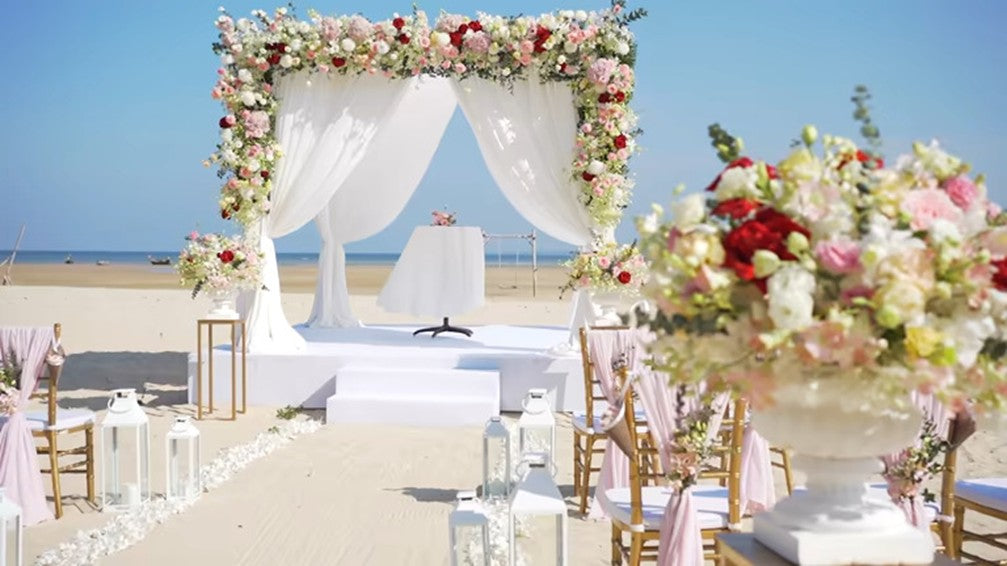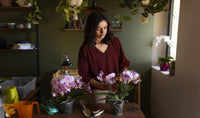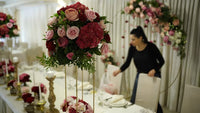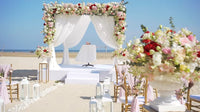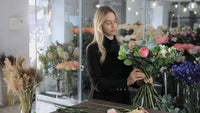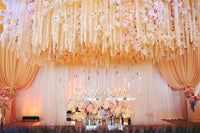Every wedding tells a unique story, and flowers help shape its visual voice. From the first glance down the aisle to the final dance, floral design weaves mood into every moment. At The Botanical Lounge, we believe a well-chosen floral theme elevates your celebration with grace and meaning. We work with couples to craft floral themes that speak to their story, season, and setting.
Table of Contents
- Key Takeaways
- 1. Start with Your Wedding Vision and Style
- 2. Consider Your Color Palette
- 3. Match the Florals to Your Venue
- 4. Factor in the Season
- 5. Think Beyond the Bouquet
- 6. Set a Realistic Budget
- 7. Choose a Florist Who Understands Your Vision
- Conclusion
- FAQs:
Key Takeaways
- Align your floral theme with the style and seasonal setting of your venue.
- Color palette and flower texture shape the mood.
- Floral structure should reflect your personality and vision.
- Let your dress, decor, and surroundings guide design choices.
- Work with a floral artist to bring harmony and detail to life.
Flowers have the power to set the tone, style, and emotion of a wedding. They add color, texture, fragrance, and a sense of celebration to every part of the big day. But with so many styles, colors, and arrangements to choose from, flower arrangements at wedding events can quickly become overwhelming. The key is to choose a floral theme that complements your venue, reflects your style, and enhances the overall wedding aesthetic.
From soft romantic tones to bold, modern structures, the right theme sets the tone before your guests hear the first vows. Let’s explore how to choose a theme that’s visually balanced, emotionally resonant, and distinctively you.
1. Start with Your Wedding Vision and Style
Before you even start looking at flowers, think about the overall style and mood you want your wedding to have. Are you dreaming of a romantic garden ceremony, a glamorous ballroom reception, or a relaxed beachside event? Your floral theme should support and enhance that vision, while also reflecting any wedding traditions that are meaningful to you, whether cultural, personal, or family-inspired. It should also complement key elements like your wedding dress, venue decor, and color palette to create a cohesive look.
Here are some popular wedding styles and matching floral themes:
- Romantic: Soft pastels, peonies, roses, and baby’s breath
- Rustic: Wildflowers, greenery, sunflowers, burlap-wrapped bouquets
- Modern: Minimalist arrangements, orchids, calla lilies, and structured designs
- Bohemian: Pampas grass, proteas, earthy tones, and dried flowers
- Classic/Elegant: White roses, hydrangeas, cascading greenery, traditional arrangements
- Tropical: Bright colors, anthuriums, birds of paradise, palm leaves
Once you’ve defined your style, it becomes much easier to narrow down your floral options.
2. Consider Your Color Palette
Your floral theme should complement and flow seamlessly with your wedding color palette. Flowers are one of the most visual elements of a wedding, and they help tie together the attire, table settings, and venue decor.
To choose the right floral colors:
- Start with your primary wedding colors, and then choose complementary floral shades.
- Consider the seasonal availability of blooms in those colors.
- Don’t be afraid to mix in neutrals (white, cream, greenery) for balance.
- Work with a florist to avoid overly matchy-matchy arrangements; slight contrasts can add visual interest.
For example, if your wedding colors are blush and gold, opt for soft pink roses, ivory peonies, and accents of greenery, with gold ribbons or vases to tie it all together.
3. Match the Florals to Your Venue
Your venue plays a big role in determining what floral styles will look best. A lavish ballroom may call for elegant centerpieces and dramatic arrangements, while a vineyard or barn venue might lend itself to rustic, loose bouquets and wildflowers.
Tips for aligning florals with your venue:
- Outdoor/garden weddings: Embrace natural blooms that blend with the scenery.
- Indoor/formal venues: Use statement florals like orchids, tall centerpieces, and chandeliers of flowers.
- Beaches or destination weddings: Choose hardy tropical flowers that won’t wilt in the sun.
- Small/intimate venues: Keep arrangements simple and space-conscious.
Always ask your florist to visit the venue or review photos to ensure the floral theme works harmoniously within the space.
4. Factor in the Season
Seasonal flowers are not only more affordable but also fresher and more environmentally friendly. Choosing flowers that are in season can naturally shape and support your overall floral theme.
Here’s a quick guide to floral ideas by season:
- Spring: Tulips, daffodils, peonies, cherry blossoms
- Summer: Roses, sunflowers, daisies, hydrangeas
- Autumn: Dahlias, marigolds, chrysanthemums, berries, rich tones
- Winter: Amaryllis, anemones, holly, white roses, evergreen accents
A winter wedding, for instance, might feature a white and green theme with hints of red berries, while a spring wedding could embrace a soft pastel floral theme with garden roses and lilacs.
5. Think Beyond the Bouquet
While the bride’s bouquet is often the centerpiece of a floral theme, don’t forget to carry that theme throughout other parts of your wedding. Consider how your floral theme will look in:
- Bridesmaids’ bouquets and boutonnieres
- Ceremony arch or aisle decor
- Reception centerpieces and table arrangements
- Floral installations or backdrops for photos
- Cake decorations (floral toppers or accents)
Maintaining a consistent floral theme across all elements of the day ensures a polished and cohesive look.
6. Set a Realistic Budget
Floral costs can add up quickly, so it’s important to define your budget early and communicate it clearly with your florist. A typical wedding floral budget can range from 8% to 15% of your total wedding budget, depending on how elaborate your plans are.
Tips to stay within budget:
- Use seasonal flowers to reduce costs.
- Repurpose ceremony flowers for the reception.
- Mix premium flowers with budget-friendly greenery like eucalyptus or ferns.
- Go for larger blooms (like hydrangeas or sunflowers) that fill more space with fewer stems.
Your florist can recommend substitutions and design hacks to help you achieve your desired look without overspending.
7. Choose a Florist Who Understands Your Vision
An experienced florist can translate your vision into a floral theme that feels cohesive and refined. When it comes to wedding flowers, it’s important to choose someone whose past work matches your desired style and who is willing to listen and collaborate. Share your inspiration boards, venue details, and budget upfront to ensure everyone’s on the same page.
Questions to ask your florist:
- Can you work within my budget?
- Which flowers will be in season on my wedding day?
- Do you offer setup and breakdown services?
- Can you show examples of similar floral themes you’ve done?
Conclusion
Your wedding should feel like your story brought to life, one petal at a time. At The Botanical Lounge, we specialize in creating thoughtful, artistic floral themes that mirror the beauty of your day.
From concept to bouquet, we’re here to guide you through every step. Reach out today to schedule your consultation.
FAQs:
How do I choose a floral theme for my wedding?
Start with your venue, season, and personal style. Consider your color palette, floral preferences, and how flowers will integrate into the space.
What flowers are best for weddings?
Popular choices include roses, peonies, ranunculus, and hydrangeas. Your florist may also recommend seasonal options for better quality and value.
Can I have a custom floral theme designed?
Absolutely. At The Botanical Lounge, we offer bespoke floral designs tailored to your wedding vision, palette, and preferences.
Should I match my bouquet to the bridesmaids’ flowers?
Your bouquet can be unique, but harmonizing with bridesmaids’ arrangements creates visual cohesion across photos and ceremony settings.
Are fresh flowers better than silk for weddings?
Fresh flowers provide authentic beauty, fragrance, and texture. Silk is durable and reusable but may lack the vibrancy of real blooms.
What is the ideal time to book a florist for my wedding?
It’s best to book 6–9 months in advance to secure your date and begin theme development with your floral designer.

